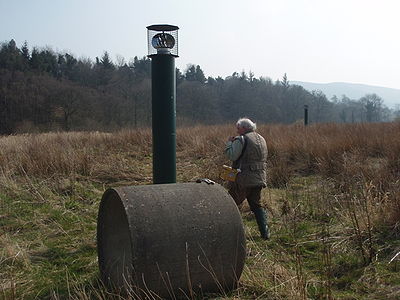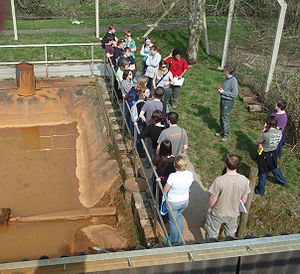
Nantmel Landfill Site
Encyclopedia

Llandrindod Wells
Llandrindod Wells , colloquially known locally as "Llandod", is a town and community in Powys, within the historic boundaries of Radnorshire, mid Wales, United Kingdom. It was developed as a spa town in the 19th century, with a boom in the late 20th century as a centre of local government. Before...
, Powys
Powys
Powys is a local-government county and preserved county in Wales.-Geography:Powys covers the historic counties of Montgomeryshire and Radnorshire, most of Brecknockshire , and a small part of Denbighshire — an area of 5,179 km², making it the largest county in Wales by land area.It is...
, Wales
Wales
Wales is a country that is part of the United Kingdom and the island of Great Britain, bordered by England to its east and the Atlantic Ocean and Irish Sea to its west. It has a population of three million, and a total area of 20,779 km²...
. It operated from 1960 to 1990, accepting domestic, commercial, non-hazardous industrial, inert and asbestos
Asbestos
Asbestos is a set of six naturally occurring silicate minerals used commercially for their desirable physical properties. They all have in common their eponymous, asbestiform habit: long, thin fibrous crystals...
waste. It was one of 80 municipal landfill
Landfill
A landfill site , is a site for the disposal of waste materials by burial and is the oldest form of waste treatment...
sites in Powys, of which all have now closed. Three privately owned sites still operate within the county. The site still produces significant pollutants, in the form of gas
Biogas
Biogas typically refers to a gas produced by the biological breakdown of organic matter in the absence of oxygen. Organic waste such as dead plant and animal material, animal dung, and kitchen waste can be converted into a gaseous fuel called biogas...
and leachate
Leachate
Leachate is any liquid that, in passing through matter, extracts solutes, suspended solids or any other component of the material through which it has passed....
from landfill decomposition
Decomposition
Decomposition is the process by which organic material is broken down into simpler forms of matter. The process is essential for recycling the finite matter that occupies physical space in the biome. Bodies of living organisms begin to decompose shortly after death...
, and is currently undergoing rehabilitation
Land rehabilitation
Land rehabilitation is the process of returning the land in a given area to some degree of its former state, after some process has resulted in its damage...
.
Structure
The 8.5haHectare
The hectare is a metric unit of area defined as 10,000 square metres , and primarily used in the measurement of land. In 1795, when the metric system was introduced, the are was defined as being 100 square metres and the hectare was thus 100 ares or 1/100 km2...
site was constructed in a valley, with the stream piped underneath and the waste lain on top, forming the present day dome shape, characteristic of many landfills. Unlike modern landfills, which are impermeably sealed with geomembranes
Geomembranes
Geomembranes are a kind of geosynthetic material made up of an impermeable membranes. Their use includes lining canals, ponds and also waste containment.-Composition:Geomembranes are made of various materials...
, Nantmel was engineered without effective base and cap layers, for instance subsoil
Subsoil
Subsoil, or substrata, is the layer of soil under the topsoil on the surface of the ground. The subsoil may include substances such as clay and/or sand that has only been partially broken down by air, sunlight, water, wind etc., to produce true soil...
from a local road-widening scheme was used instead of a liner.
Intended to be reclaimed for pastoral
Pastoral
The adjective pastoral refers to the lifestyle of pastoralists, such as shepherds herding livestock around open areas of land according to seasons and the changing availability of water and pasturage. It also refers to a genre in literature, art or music that depicts such shepherd life in an...
purposes, the site was fenced, but the availability of higher quality pasture in the surrounding fields led to little interest from farmers. Without the compaction and grazing by farm animals, the plants and topsoil
Topsoil
Topsoil is the upper, outermost layer of soil, usually the top to . It has the highest concentration of organic matter and microorganisms and is where most of the Earth's biological soil activity occurs.-Importance:...
became low quality, and the intention now appears to leave the site for conservation
Conservation ethic
Conservation is an ethic of resource use, allocation, and protection. Its primary focus is upon maintaining the health of the natural world: its, fisheries, habitats, and biological diversity. Secondary focus is on materials conservation and energy conservation, which are seen as important to...
purposes.
Leachate treatment

Disperse
Disperse is a Christian Rock band from Southern Indiana. The band was formerly known, with an adjusted roster, as "Stuff."-Members :...
principle', producing up to 600 tonnes of leachate a day. This cost the council £330,000 per annum to remove in tankers to Hereford
Hereford
Hereford is a cathedral city, civil parish and county town of Herefordshire, England. It lies on the River Wye, approximately east of the border with Wales, southwest of Worcester, and northwest of Gloucester...
. In 1996 the installation of an on-site treatment system means costs are now just £65,000 per annum, a move commended by the Environment Agency
Environment Agency
The Environment Agency is a British non-departmental public body of the Department for Environment, Food and Rural Affairs and an Assembly Government Sponsored Body of the Welsh Assembly Government that serves England and Wales.-Purpose:...
.
The current system (detailed in) consists of an S3 Environmental Solutions Ltd nitrification
Nitrification
Nitrification is the biological oxidation of ammonia with oxygen into nitrite followed by the oxidation of these nitrites into nitrates. Degradation of ammonia to nitrite is usually the rate limiting step of nitrification. Nitrification is an important step in the nitrogen cycle in soil...
tower (a trickling filter
Trickling filter
A trickling filter consists of a fixed bed of rocks, lava, coke, gravel, slag, polyurethane foam, sphagnum peat moss, ceramic, or plastic media over which sewage or other wastewater flows downward and causes a layer of microbial slime to grow, covering the bed of media...
also known as an aeration
Aeration
Aeration is the process by which air is circulated through, mixed with or dissolved in a liquid or substance.-Aeration of liquids:-Methods:Aeration of liquids is achieved by:...
or biofilm
Biofilm
A biofilm is an aggregate of microorganisms in which cells adhere to each other on a surface. These adherent cells are frequently embedded within a self-produced matrix of extracellular polymeric substance...
tower) through which the leachate is circulated over a biofilm
Biofilm
A biofilm is an aggregate of microorganisms in which cells adhere to each other on a surface. These adherent cells are frequently embedded within a self-produced matrix of extracellular polymeric substance...
supported on a plastic media. The partially-treated leachate then leaves behind iron
Iron
Iron is a chemical element with the symbol Fe and atomic number 26. It is a metal in the first transition series. It is the most common element forming the planet Earth as a whole, forming much of Earth's outer and inner core. It is the fourth most common element in the Earth's crust...
-rich sludge in the leachate lagoon (visibly stained orange; see photo to the left and satellite images) and is polished in a series of reed
Reed bed
Reed beds are natural habitats found in floodplains, waterlogged depressions andestuaries. Reed beds are part of a succession from young reed colonising open water or wet ground through a gradation of increasingly dry ground...
and gravel
Gravel
Gravel is composed of unconsolidated rock fragments that have a general particle size range and include size classes from granule- to boulder-sized fragments. Gravel can be sub-categorized into granule and cobble...
filter beds and a wetland
Wetland
A wetland is an area of land whose soil is saturated with water either permanently or seasonally. Wetlands are categorised by their characteristic vegetation, which is adapted to these unique soil conditions....
system. By this point the leachate meets water quality levels, and so can be released into the river system.
The tower maintains aerobic conditions, favourable for the biofilm within, which allows:
- the degradation of organicOrganic matterOrganic matter is matter that has come from a once-living organism; is capable of decay, or the product of decay; or is composed of organic compounds...
components, - metallic ions to be oxidised to insoluble forms (e.g. ferrous iron to ferricFerricFerric refers to iron-containing materials or compounds. In chemistry the term is reserved for iron with an oxidation number of +3, also denoted iron or Fe3+. On the other hand, ferrous refers to iron with oxidation number of +2, denoted iron or Fe2+...
iron), - ammoniaAmmoniaAmmonia is a compound of nitrogen and hydrogen with the formula . It is a colourless gas with a characteristic pungent odour. Ammonia contributes significantly to the nutritional needs of terrestrial organisms by serving as a precursor to food and fertilizers. Ammonia, either directly or...
to be oxidised (via nitriteNitriteThe nitrite ion has the chemical formula NO2−. The anion is symmetric with equal N-O bond lengths and a O-N-O bond angle of ca. 120°. On protonation the unstable weak acid nitrous acid is produced. Nitrite can be oxidised or reduced, with product somewhat dependent on the oxidizing/reducing agent...
) to nitrateNitrateThe nitrate ion is a polyatomic ion with the molecular formula NO and a molecular mass of 62.0049 g/mol. It is the conjugate base of nitric acid, consisting of one central nitrogen atom surrounded by three identically-bonded oxygen atoms in a trigonal planar arrangement. The nitrate ion carries a...
, - remaining metals to precipitate into the lagoon sludge with ferric hydroxides.
Among other pollutants, this system removes the leachate's high Biological Oxygen Demand, the ammoniacal nitrogen
Nitrogen
Nitrogen is a chemical element that has the symbol N, atomic number of 7 and atomic mass 14.00674 u. Elemental nitrogen is a colorless, odorless, tasteless, and mostly inert diatomic gas at standard conditions, constituting 78.08% by volume of Earth's atmosphere...
and ferrous iron contents.
Gas management
Landfill contents quickly degrade through the aerobic stage (1 week), and the acetogenic stages (approximately 1 month), and so Nantmel is now in the methanogenic stage (20-40 years), producing large amounts of methaneMethane
Methane is a chemical compound with the chemical formula . It is the simplest alkane, the principal component of natural gas, and probably the most abundant organic compound on earth. The relative abundance of methane makes it an attractive fuel...
, a potent greenhouse gas
Greenhouse gas
A greenhouse gas is a gas in an atmosphere that absorbs and emits radiation within the thermal infrared range. This process is the fundamental cause of the greenhouse effect. The primary greenhouse gases in the Earth's atmosphere are water vapor, carbon dioxide, methane, nitrous oxide, and ozone...
. At other larger sites this gas is captured and burnt for energy (see Biogas
Biogas
Biogas typically refers to a gas produced by the biological breakdown of organic matter in the absence of oxygen. Organic waste such as dead plant and animal material, animal dung, and kitchen waste can be converted into a gaseous fuel called biogas...
), but at Nantmel it is passively vented into the atmosphere (see top photo). In densely populated areas this would be impossible due to the asphyxiation risk. As the waste stabilises, methane production will reduce.

